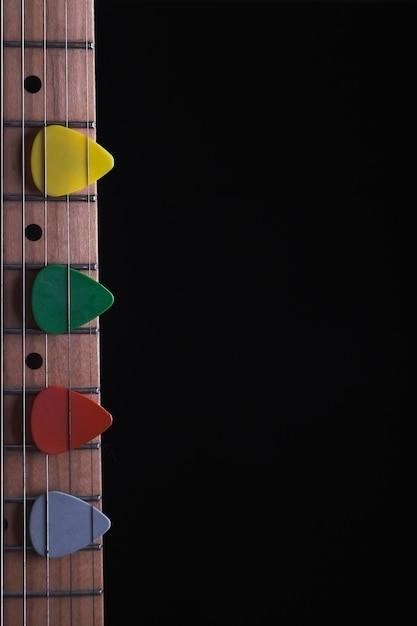Pentatonic Scales for Guitar
Pentatonic scales are a fundamental building block for guitarists, offering a simple yet powerful framework for improvisation, soloing, and even rhythm playing․ They are widely used in various genres, particularly blues, rock, and jazz, due to their melodic and expressive nature․ This guide delves into the world of pentatonic scales, exploring their structure, types, and applications for guitar․
Introduction to Pentatonic Scales
Pentatonic scales, meaning “five-note scales,” are a fundamental element of music theory and a cornerstone for guitarists of all levels․ They offer a streamlined approach to improvisation and soloing, providing a framework for creating melodic lines that are both engaging and accessible․ The beauty of pentatonic scales lies in their simplicity; with only five notes, they create a sense of musical coherence and flow, allowing guitarists to express themselves with a focused and impactful sound․
These scales are derived from the major and minor scales, omitting certain notes to create a distinctive sound․ The resulting five-note patterns are highly versatile and adaptable, seamlessly fitting into various musical contexts․ Whether you’re exploring bluesy licks, crafting rock riffs, or venturing into jazz improvisation, pentatonic scales provide a solid foundation for your musical explorations․
The pentatonic scales are often described as being “natural” or “intuitive” due to their inherent musicality․ The absence of certain notes creates a sense of space and freedom, allowing guitarists to explore different melodic possibilities without the constraints of a full seven-note scale․ This characteristic makes them particularly appealing for beginners who are just starting to learn improvisation and soloing techniques․
The pentatonic scales are often referred to as “the most important scales for guitar” due to their widespread use and their ability to provide a solid foundation for further musical development․ Mastering these scales opens up a world of possibilities for guitarists, enabling them to express themselves creatively and confidently across a broad range of musical styles․
Types of Pentatonic Scales
The world of pentatonic scales encompasses two primary types⁚ the major pentatonic and the minor pentatonic․ These scales, while sharing a common five-note structure, possess distinct characteristics that shape their overall feel and application․ The major pentatonic scale, often associated with a bright and uplifting mood, finds its roots in the major scale․ It’s characterized by its use of the root, major second, major third, perfect fifth, and major sixth intervals, resulting in a sound that is typically considered happy, optimistic, and energetic;
In contrast, the minor pentatonic scale, rooted in the minor scale, carries a more melancholic and introspective vibe․ It utilizes the root, minor third, perfect fourth, perfect fifth, and minor seventh intervals, creating a sound that is often described as somber, introspective, and emotionally evocative․ These two scales, along with their variations, provide a versatile toolbox for guitarists, allowing them to explore a wide range of musical emotions and create a diverse palette of sonic textures․
Beyond the major and minor pentatonic scales, there are other variations that expand the pentatonic landscape․ The blues scale, a close relative of the minor pentatonic, incorporates a flatted fifth note, adding a characteristic bluesy character to its sound․ This scale, often associated with soulful and expressive playing, has become a staple in blues, rock, and even jazz music․
Understanding the different types of pentatonic scales and their unique characteristics is crucial for guitarists․ It allows them to choose the most suitable scale for a particular musical context, enhancing their ability to create expressive and captivating melodies․ The versatility of pentatonic scales makes them a valuable tool for any guitarist looking to expand their musical vocabulary and explore the world of improvisation and soloing․
The Minor Pentatonic Scale
The minor pentatonic scale, a five-note scale derived from the natural minor scale, is a cornerstone of blues, rock, and jazz guitar improvisation․ Its structure, consisting of the root, minor third, perfect fourth, perfect fifth, and minor seventh intervals, creates a sound that is both melancholic and expressive, often associated with a sense of introspection and emotional depth․
The minor pentatonic scale is often the first pentatonic scale that guitarists learn due to its simplicity and ease of application․ Its five notes, played in a specific pattern, form a melodic framework that allows for a wide range of improvisational possibilities․ Its inherent “minor” character lends itself to a variety of musical styles, from soulful blues to brooding rock and everything in between․
The minor pentatonic scale’s popularity stems from its ability to create compelling melodies with relative ease․ It offers a foundation for improvisation that is both accessible and expressive․ Guitarists can explore its various positions and patterns, creating a fluid and dynamic sonic tapestry․ Furthermore, the minor pentatonic scale can be used in conjunction with other scales and techniques, allowing for even greater versatility and musical depth․
Whether it’s soloing over a bluesy progression, adding a touch of melancholy to a rock riff, or creating a haunting atmospheric soundscape, the minor pentatonic scale remains a powerful tool in the guitarist’s arsenal․ Its inherent expressiveness and versatility make it an essential element for any guitarist looking to elevate their improvisational skills and explore the full range of musical emotion․
The Major Pentatonic Scale
The major pentatonic scale, another essential building block in the guitarist’s repertoire, offers a contrasting sonic landscape to its minor counterpart․ Built using the root, major second, major third, perfect fifth, and major sixth intervals, it creates a bright, uplifting, and often joyous sound, commonly associated with a sense of optimism and energy․
While the minor pentatonic scale is known for its melancholic character, the major pentatonic scale provides a vibrant alternative, offering a different emotional palette for improvisation and soloing․ Its major character lends itself well to genres like rock, pop, and folk, adding a sense of sparkle and melody to these styles․
The major pentatonic scale, like its minor counterpart, is relatively simple to learn and apply․ Guitarists can utilize its five-note structure to create captivating melodies and solos, exploring its various positions and patterns across the fretboard․ Its characteristic major sound allows for a wide range of musical expression, from soaring leads to infectious riffs․
The major pentatonic scale provides a valuable tool for expanding a guitarist’s improvisational vocabulary․ It offers a distinct sonic character that complements and contrasts with the minor pentatonic scale, opening up a broader range of musical possibilities․ Whether it’s adding a bright melody to a rock song, creating a catchy pop hook, or adding a touch of whimsy to a folk tune, the major pentatonic scale provides a versatile tool for any guitarist seeking to enhance their musical expression․
Using Pentatonic Scales for Guitar
The beauty of pentatonic scales lies in their versatility and ease of application, making them a fundamental tool for guitarists across various genres․ Whether you’re a seasoned pro or a beginner, understanding their use can unlock a world of musical possibilities․
One of the most common applications of pentatonic scales is in soloing․ Their limited number of notes provides a framework for improvising melodies while maintaining a cohesive and pleasing sound․ By understanding the scale’s intervals, you can create interesting lines and phrases, adding depth and expression to your solos․

Pentatonic scales also serve as a foundation for creating compelling rhythm parts․ Their characteristic melodic nature lends itself to creating engaging riffs and chord progressions․ You can use them to build simple but impactful chord structures, or to create more complex rhythmic patterns that add texture and groove to your playing․
Beyond soloing and rhythm, pentatonic scales can be used in various other ways․ They serve as a foundation for exploring different musical styles, from blues and rock to jazz and folk․ They can also be used to create unique and expressive melodic lines within existing songs, adding your own personal touch to familiar tunes․
The ability to apply pentatonic scales effectively opens up a vast range of musical possibilities․ Whether you’re adding a soulful solo to a blues track, creating a driving riff for a rock song, or simply enriching your overall musical vocabulary, understanding these scales is an essential step for any guitarist․
Pentatonic Scale Patterns
Understanding pentatonic scale patterns is crucial for navigating the fretboard efficiently and playing these scales smoothly․ There are five basic positions or patterns for each pentatonic scale, each covering a specific section of the fretboard․ Learning these patterns allows you to play the pentatonic scale in any key without memorizing individual notes․
The patterns are typically referred to as “boxes” because they visually resemble rectangular shapes on the fretboard․ Each box contains the five notes of the pentatonic scale, arranged in a specific order․ These patterns are interconnected, meaning that they overlap and transition seamlessly into each other․ By mastering these five patterns, you gain the ability to play the pentatonic scale across the entire fretboard․
Learning these patterns is essential for improvising effectively․ By knowing the relationships between the notes within each pattern, you can create melodic lines and phrases that flow naturally within the scale․ Additionally, these patterns provide a framework for exploring different scale variations and incorporating techniques like bending, slides, and hammer-ons․
Once you’ve mastered the basic five patterns, you can expand your knowledge by exploring variations and extensions․ These include alternate fingerings, extended patterns, and incorporating techniques like double stops and arpeggios․ As you delve deeper into pentatonic patterns, you’ll unlock a wider range of musical possibilities and develop a more comprehensive understanding of the guitar fretboard․
Pentatonic Scale Diagrams
Pentatonic scale diagrams are visual representations of the five notes within a pentatonic scale, displayed on a guitar fretboard diagram․ These diagrams are invaluable tools for learning and practicing pentatonic scales, as they provide a clear and concise visual representation of the scale’s structure and note positions․
Pentatonic scale diagrams typically show the fretboard layout, with the strings represented as horizontal lines and the frets as vertical lines․ The notes of the pentatonic scale are marked on the fretboard diagram using dots, circles, or other symbols․ The color of these symbols often distinguishes between the root note and the other notes of the scale․
These diagrams are particularly useful for visualizing the five basic patterns or “boxes” of the pentatonic scale․ Each pattern covers a specific section of the fretboard and contains all five notes of the scale․ By studying these diagrams, you can understand how the patterns connect and transition into each other, creating a seamless flow across the entire fretboard․
Many online resources and guitar books provide pentatonic scale diagrams for various keys and scales, making it easy to find and learn them․ Using these diagrams alongside practice sessions can significantly enhance your understanding and mastery of pentatonic scales․
Learning Pentatonic Scales
Learning pentatonic scales on guitar is a rewarding journey that opens up a world of musical possibilities․ Mastering these scales provides you with a solid foundation for improvisation, soloing, and understanding musical harmony․ There are several effective approaches to learning pentatonic scales, each catering to different learning styles and preferences․
One common method is to start with the minor pentatonic scale, as it is often considered easier to grasp and provides a good starting point for improvisation․ Begin by learning the five basic patterns or “boxes” of the minor pentatonic scale, focusing on understanding the note positions and fingering techniques․ Practice transitioning between these patterns smoothly, building muscle memory and familiarity with the scale’s structure․
Once you feel comfortable with the minor pentatonic scale, explore the major pentatonic scale, which shares the same five-note structure but with a different intervallic arrangement․ Practice both scales in different keys, gradually expanding your knowledge and ability to play in various musical contexts․ Remember, consistency and regular practice are key to mastering pentatonic scales․
As you progress, consider incorporating visual aids like pentatonic scale diagrams and fretboard maps․ These resources can help you visualize the scale’s structure and note positions, making learning more efficient and enjoyable․ Don’t hesitate to experiment with different techniques and approaches to find what works best for you․


